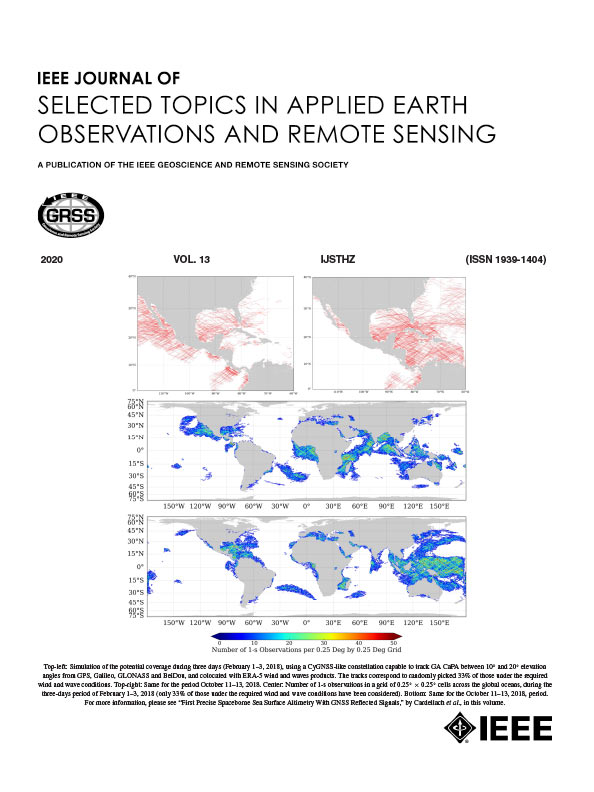Adaptive Gaussian-PSO XGBoost Model for Alpine Forests Aboveground Biomass Estimation Using Spaceborne PolSAR and LiDAR Data
IF 4.7
2区 地球科学
Q1 ENGINEERING, ELECTRICAL & ELECTRONIC
IEEE Journal of Selected Topics in Applied Earth Observations and Remote Sensing
Pub Date : 2025-04-09
DOI:10.1109/JSTARS.2025.3559233
引用次数: 0
Abstract
Accurate estimation of forest aboveground biomass (AGB) is fundamental to forest management and ecosystem monitoring. Natural forest ecosystems are an important guarantee to maintain the global ecological balance and carbon cycle, but the complex climate, dramatic topographic relief, and saturation effects make it difficult to achieve reasonable AGB estimation of alpine forests with commonly used optical data. In this study, spaceborne dual-polarimetric synthetic aperture radar and light detection and ranging data were combined to break through the limitation of optical data, and the information on the vertical structure inside the forests was extracted, to achieve high-precision forest AGB estimation and reveal the distribution pattern of forest AGB. An adaptive Gaussian-particle swarm algorithm XGBoost model (AGP-XGBOOST) was proposed to improve the forest AGB estimation, which adjusted the PSO through the built-in adaptive parameter of the Gaussian function to achieve the hyperparameter optimization for the XGBoost model. The proposed method was validated with the forest survey data, and classic machine-learning models were constructed for comparison. The comparative analysis was carried out using natural forests in the eastern Tibetan Plateau as an example, and the results showed that the proposed AGP-XGBOOST model consistently maintained the best performance across all models, and the AGB estimation errors caused by the combined data source decreased by 30.8%, 24.4%, and 10.1% compared to the independent data sources. In addition, the forest AGB mapping showed that the distribution pattern of forest AGB on the eastern Tibetan Plateau was significantly affected by terrain fluctuations.基于星载PolSAR和LiDAR数据估算高山森林地上生物量的自适应高斯- pso XGBoost模型
准确估算森林地上生物量(AGB)是森林管理和生态系统监测的基础。天然林生态系统是维持全球生态平衡和碳循环的重要保障,但复杂的气候、剧烈的地形起伏和饱和效应,使得常用的光学数据难以实现合理的高寒森林AGB估算。本研究将星载双偏振合成孔径雷达与光探测测距数据相结合,突破光学数据的限制,提取森林内部的垂直结构信息,实现森林AGB的高精度估算,揭示森林AGB的分布格局。为了改进森林AGB估计,提出了一种自适应高斯粒子群算法XGBoost模型(AGP-XGBOOST),该模型通过高斯函数内置的自适应参数对PSO进行调整,实现XGBoost模型的超参数优化。利用森林调查数据对该方法进行了验证,并构建了经典的机器学习模型进行比较。以青藏高原东部天然林为例进行对比分析,结果表明,所提出的AGP-XGBOOST模型在所有模型中始终保持最佳性能,与独立数据源相比,组合数据源导致的AGB估计误差分别降低了30.8%、24.4%和10.1%。此外,森林AGB制图表明,青藏高原东部森林AGB的分布格局受地形波动的影响显著。
本文章由计算机程序翻译,如有差异,请以英文原文为准。
求助全文
约1分钟内获得全文
求助全文
来源期刊
CiteScore
9.30
自引率
10.90%
发文量
563
审稿时长
4.7 months
期刊介绍:
The IEEE Journal of Selected Topics in Applied Earth Observations and Remote Sensing addresses the growing field of applications in Earth observations and remote sensing, and also provides a venue for the rapidly expanding special issues that are being sponsored by the IEEE Geosciences and Remote Sensing Society. The journal draws upon the experience of the highly successful “IEEE Transactions on Geoscience and Remote Sensing” and provide a complementary medium for the wide range of topics in applied earth observations. The ‘Applications’ areas encompasses the societal benefit areas of the Global Earth Observations Systems of Systems (GEOSS) program. Through deliberations over two years, ministers from 50 countries agreed to identify nine areas where Earth observation could positively impact the quality of life and health of their respective countries. Some of these are areas not traditionally addressed in the IEEE context. These include biodiversity, health and climate. Yet it is the skill sets of IEEE members, in areas such as observations, communications, computers, signal processing, standards and ocean engineering, that form the technical underpinnings of GEOSS. Thus, the Journal attracts a broad range of interests that serves both present members in new ways and expands the IEEE visibility into new areas.

 求助内容:
求助内容: 应助结果提醒方式:
应助结果提醒方式:


